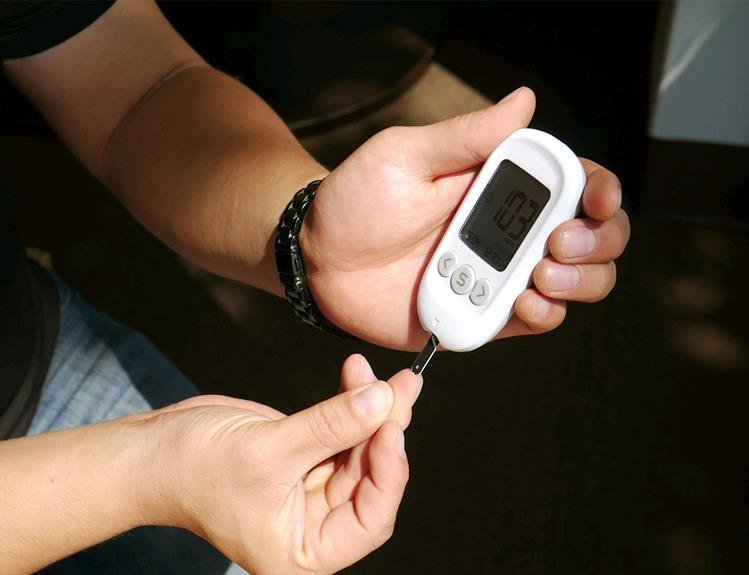Prediabetes in Children: Identifying Early Signs and Prevention Strategies
If you think childhood prediabetes is a distant concern, think again; it might be closer than you realize. Understanding the signs and implementing preventive measures can pave the way for a healthier future for your child.
By recognizing early indicators and making necessary lifestyle adjustments, you can potentially steer clear of more serious health complications down the road. Let's explore the subtle clues and proactive steps that could make all the difference in your child's well-being.
Risk Factors for Childhood Prediabetes
To understand the risk factors for childhood prediabetes, consider the influence of genetics and lifestyle choices on a child's health. Genetics play a significant role in predisposing some children to prediabetes. If there's a family history of type 2 diabetes, the child may have a higher risk of developing prediabetes. However, genetics alone don't determine the outcome.
Lifestyle choices are equally crucial. A sedentary lifestyle with minimal physical activity can contribute to weight gain and insulin resistance, increasing the risk of prediabetes. Poor dietary habits, such as excessive consumption of sugary foods and drinks, can also play a role. Encouraging your child to engage in regular physical activity and adopt a balanced diet rich in fruits, vegetables, and whole grains can help reduce the risk factors associated with prediabetes.
Common Symptoms of Prediabetes in Children
If your child is experiencing unexplained weight loss, increased thirst, or frequent urination, these could be early warning signs of prediabetes. It's crucial to monitor your child's blood sugar levels regularly to catch any potential issues early on.
Encouraging healthy lifestyle habits, such as regular exercise and a balanced diet, can also help prevent prediabetes in children.
Early Warning Signs
Noticing certain signs early on can be crucial in identifying prediabetes in children. Keep an eye out for frequent urination, excessive thirst, unexplained weight loss, fatigue, and blurred vision.
Children with prediabetes may also experience slow wound healing, darkened skin patches, or tingling in the hands and feet. If your child exhibits these symptoms, it's essential to consult a healthcare provider for proper evaluation and diagnosis.
Early detection of prediabetes can help prevent the progression to type 2 diabetes through lifestyle changes like a healthy diet and regular physical activity. Stay vigilant and proactive in recognizing these warning signs to safeguard your child's health and well-being.
Monitoring Blood Sugar
Keeping track of your child's blood sugar levels is essential in monitoring common symptoms of prediabetes. Regularly checking their blood sugar can help identify any fluctuations or abnormalities that may indicate prediabetes.
Common symptoms to watch out for include increased thirst, frequent urination, fatigue, blurred vision, and slow wound healing. By monitoring blood sugar levels, you can catch these signs early and seek medical advice promptly.
It's important to create a routine for checking blood sugar, especially if your child is at risk for prediabetes due to factors like family history, obesity, or lack of physical activity. Remember, early detection and management are key in preventing prediabetes from progressing to type 2 diabetes.
Healthy Lifestyle Habits
To help your child prevent prediabetes from progressing, instilling healthy lifestyle habits is crucial. Encourage regular physical activity to help maintain a healthy weight and regulate blood sugar levels.
Limit sugary drinks and snacks, opting for fruits, vegetables, and whole grains instead. Make mealtimes a priority, ensuring balanced and nutritious meals.
Incorporate family activities that promote movement and reduce sedentary behaviors. Monitor screen time and encourage outdoor play.
Ensure your child gets an adequate amount of sleep each night to support overall health. By making these lifestyle changes, you can help your child reduce the risk of developing prediabetes and promote a healthier future.
Diagnostic Tests for Prediabetes
When assessing prediabetes in children, testing blood sugar levels and assessing insulin resistance are crucial steps. These diagnostic tests provide valuable insights into the child's metabolic health and can help identify prediabetes early on.
Testing Blood Sugar Levels
For diagnosing prediabetes in children, healthcare providers commonly use diagnostic tests to measure blood sugar levels accurately.
One of the most common tests is the fasting blood sugar test. In this test, you'll be asked to fast overnight, and then your blood sugar levels will be checked in the morning.
Another test is the oral glucose tolerance test (OGTT). During this test, you'll first have your fasting blood sugar level checked, then you'll drink a sugary solution, and your blood sugar levels will be monitored over the next few hours.
These tests help healthcare providers identify if your blood sugar levels are higher than normal, indicating potential prediabetes.
Assessing Insulin Resistance
Assess insulin resistance in children by undergoing diagnostic tests to determine the likelihood of prediabetes.
A commonly used test is the fasting blood sugar test, which measures blood sugar levels after an overnight fast.
Another effective test is the oral glucose tolerance test, where blood sugar levels are checked before and after consuming a sugary drink.
Additionally, the HbA1c test provides information about average blood sugar levels over the past few months.
Insulin levels can also be measured through a fasting insulin test, helping to assess how well the body is managing blood sugar.
These tests play a crucial role in identifying insulin resistance early on, allowing for timely intervention to prevent the progression to type 2 diabetes.
Lifestyle Changes to Prevent Prediabetes
To prevent prediabetes, consider making gradual lifestyle changes that promote healthier habits. Start by incorporating more fruits, vegetables, whole grains, and lean proteins into your daily meals. These foods can help regulate blood sugar levels and prevent insulin spikes. Additionally, reduce your intake of sugary drinks, processed foods, and high-fat snacks, as they can contribute to insulin resistance.
Another essential lifestyle change is to prioritize regular physical activity. Aim for at least 30 minutes of moderate exercise most days of the week. This can help improve insulin sensitivity and lower the risk of developing prediabetes. Find activities you enjoy, whether it's walking, swimming, dancing, or playing sports.
Managing stress levels is also crucial in preventing prediabetes. Practice relaxation techniques like deep breathing, meditation, or yoga to help reduce stress and improve overall well-being. Getting an adequate amount of quality sleep each night is equally important, as lack of sleep can affect hormone levels and insulin sensitivity.
Importance of Regular Physical Activity
Consider incorporating regular physical activity into your routine as a key component in preventing prediabetes and improving overall health. Engaging in activities such as brisk walking, jogging, cycling, or playing sports not only helps maintain a healthy weight but also reduces the risk of developing prediabetes. Physical activity aids in lowering blood sugar levels by increasing insulin sensitivity, which is crucial in preventing prediabetes from progressing to type 2 diabetes.
Regular exercise also contributes to better heart health, improved circulation, and enhanced metabolism. It can help control blood pressure, reduce cholesterol levels, and strengthen your cardiovascular system, all of which are beneficial in preventing prediabetes. Moreover, physical activity boosts mood, reduces stress, and enhances overall well-being, which are essential for maintaining a healthy lifestyle.
To reap the full benefits, aim for at least 150 minutes of moderate-intensity exercise per week, spread out over several days. Remember, staying active not only helps prevent prediabetes but also promotes a healthier and happier life overall.
Nutritional Strategies for Prediabetes Prevention
Incorporate nutrient-rich foods into your daily meals to help prevent prediabetes and support overall health. Focus on a balanced diet that includes plenty of fruits, vegetables, whole grains, lean proteins, and healthy fats. Limit foods high in added sugars, saturated fats, and refined carbohydrates, as they can contribute to insulin resistance and increase the risk of developing prediabetes.
Make water your beverage of choice and reduce consumption of sugary drinks like sodas, sports drinks, and sweetened juices. Water helps keep you hydrated without adding extra calories or sugar to your diet.
Include fiber-rich foods such as legumes, nuts, seeds, and whole grains in your meals to help regulate blood sugar levels and improve insulin sensitivity. Fiber also aids in digestion and can help you feel full and satisfied after eating.
Be mindful of portion sizes and avoid overeating, which can lead to weight gain and increase the risk of developing prediabetes. Eating slowly and listening to your body's hunger cues can help you maintain a healthy weight and prevent insulin resistance.
Frequently Asked Questions
Can Children Outgrow Prediabetes or Is It a Lifelong Condition?
You may have prediabetes as a child, but with healthy lifestyle changes like diet and exercise, you can often reverse it. It's possible to outgrow prediabetes and prevent it from becoming a lifelong condition through proactive steps.
Are There Any Specific Medications Available to Treat Prediabetes in Children?
You know what's funny? When it comes to treating prediabetes in children, there are actually no specific medications available. Instead, focus on lifestyle changes like a balanced diet and regular exercise for better outcomes.
How Often Should Children With Prediabetes Have Their Blood Sugar Levels Monitored?
You should have your child's blood sugar levels monitored regularly if they have prediabetes. This helps track their progress and ensure timely intervention. Consulting with healthcare providers can determine the appropriate frequency for monitoring to manage their condition effectively.
Are There Any Support Groups or Resources Available for Parents of Children With Prediabetes?
You might think you're alone, but many resources and support groups exist for parents of children with prediabetes. These groups offer guidance, understanding, and a sense of community to help you navigate this journey.
Can Prediabetes in Children Lead to Other Health Complications Later in Life?
Yes, prediabetes in children can lead to other health complications later in life. It's important to monitor and manage their condition early on to reduce the risk of developing more severe health issues in the future.
Conclusion
You've learned about the warning signs and prevention strategies for childhood prediabetes. Remember, just like a plant needs sunlight and water to thrive, your child's health requires proper care and attention.
By staying active, eating well, and getting regular check-ups, you can help your child grow into a healthy and strong individual.
Don't wait for the storm to come, plant the seeds of good health now.





